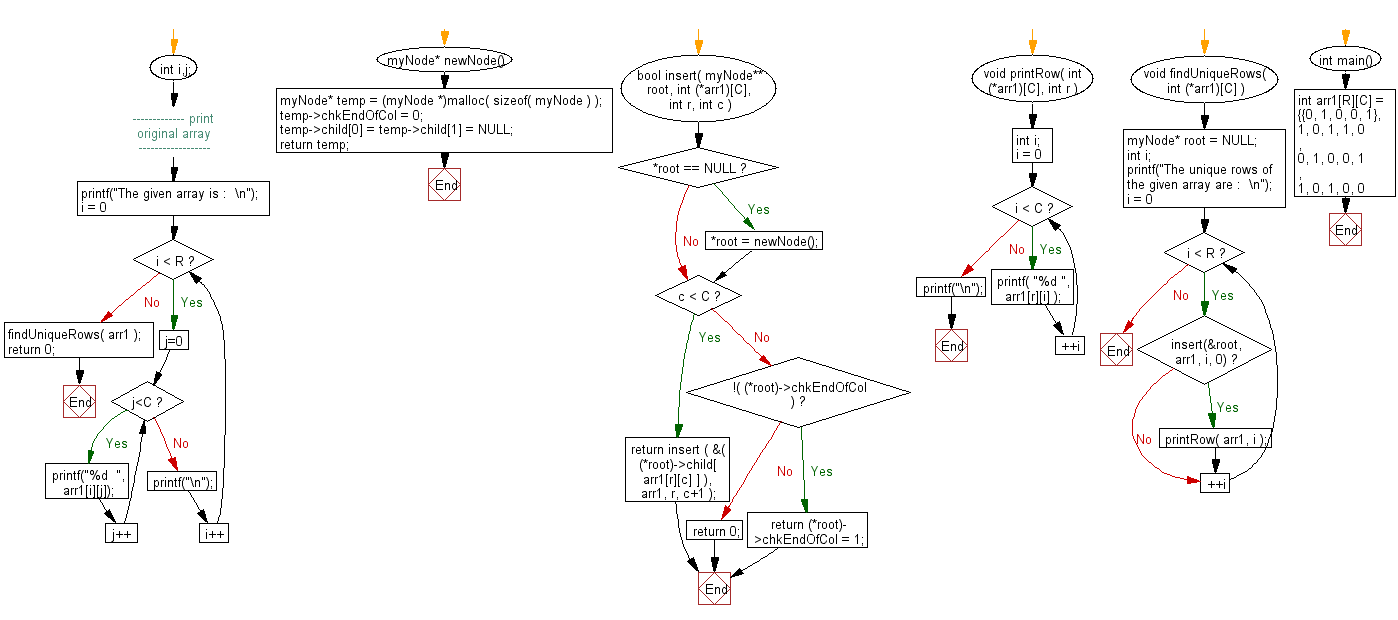C Exercises: Return only the unique rows from a given binary matrix
72. Unique Rows from Binary Matrix
Write a program in C to return only the unique rows from a given binary matrix.
Expected Output:
The given array is :
0 1 0 0 1
1 0 1 1 0
0 1 0 0 1
1 0 1 0 0
The unique rows of the given array are :
0 1 0 0 1
1 0 1 1 0
1 0 1 0 0
The task is to write a C program that identifies and returns only the unique rows from a given binary matrix. The program should iterate through the matrix, compare each row with the others, and extract only those rows that are distinct from all others. The unique rows should then be displayed in the same order they appear in the original matrix.
Sample Solution:
C Code:
#include <stdio.h>
#include <stdlib.h>
#include <stdbool.h>
#define R 4 // Number of rows
#define C 5 // Number of columns
// Struct definition for trie node
typedef struct Node {
bool chkEndOfCol; // Indicates the end of a row
struct Node *child[2]; // Child nodes (left and right)
} myNode;
// Function to create a new node for the trie
myNode* newNode() {
myNode* temp = (myNode *)malloc( sizeof( myNode ) );
temp->chkEndOfCol = 0;
temp->child[0] = temp->child[1] = NULL;
return temp;
}
// Function to insert a row into the trie
bool insert(myNode** root, int (*arr1)[C], int r, int c) {
// If root is NULL, create a new node
if (*root == NULL)
*root = newNode();
// If within columns, continue inserting
if (c < C)
return insert(&((*root)->child[arr1[r][c]]), arr1, r, c+1);
else {
// If end of column, mark it in the trie
if (!((*root)->chkEndOfCol))
return (*root)->chkEndOfCol = 1;
return 0;
}
}
// Function to print a row of the array
void printRow(int (*arr1)[C], int r) {
int i;
for (i = 0; i < C; ++i)
printf("%d ", arr1[r][i]);
printf("\n");
}
// Function to find and print unique rows of the array
void findUniqueRows(int (*arr1)[C]) {
myNode* root = NULL;
int i;
printf("The unique rows of the given array are :\n");
for (i = 0; i < R; ++i) {
// If row is inserted into trie (i.e., not a duplicate), print the row
if (insert(&root, arr1, i, 0))
printRow(arr1, i);
}
}
int main() {
int arr1[R][C] = {
{0, 1, 0, 0, 1},
{1, 0, 1, 1, 0},
{0, 1, 0, 0, 1},
{1, 0, 1, 0, 0}
};
int i, j;
// Print the original array
printf("The given array is :\n");
for (i = 0; i < R; i++) {
for (j = 0; j < C; j++) {
printf("%d ", arr1[i][j]);
}
printf("\n");
}
// Find and print unique rows of the array
findUniqueRows(arr1);
return 0;
}
Output:
The given array is : 0 1 0 0 1 1 0 1 1 0 0 1 0 0 1 1 0 1 0 0 The unique rows of the given array are : 0 1 0 0 1 1 0 1 1 0 1 0 1 0 0
Flowchart:/p>
For more Practice: Solve these Related Problems:
- Write a C program to extract and print only the unique rows from a given binary matrix using hash mapping.
- Write a C program to compare rows of a binary matrix and print those that do not repeat.
- Write a C program to remove duplicate rows from a binary matrix and display the resulting matrix.
- Write a C program to identify unique rows in a binary matrix using bitwise operations for row comparisons.
Go to:
PREV : Median of Two Sorted Arrays (Different Sizes).
NEXT : Print All Unique Elements (Unsorted Array).
C Programming Code Editor:
Have another way to solve this solution? Contribute your code (and comments) through Disqus.
What is the difficulty level of this exercise?
Test your Programming skills with w3resource's quiz.

